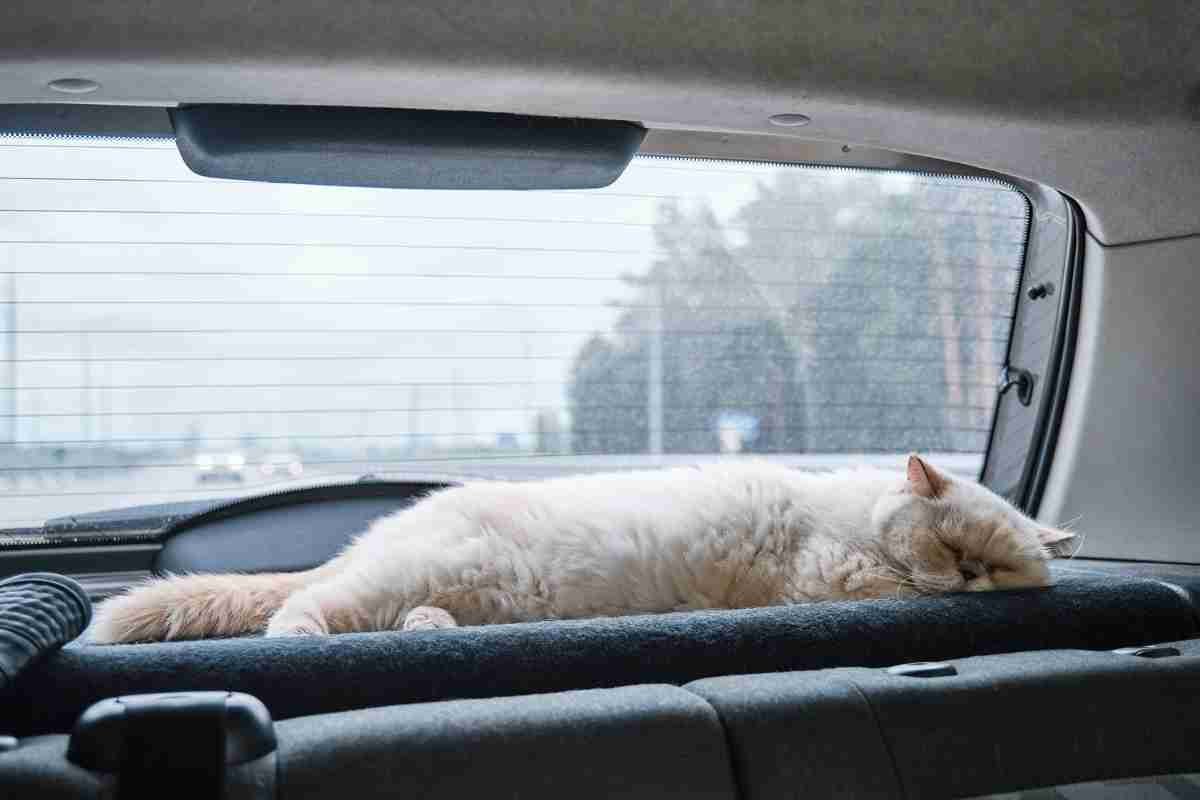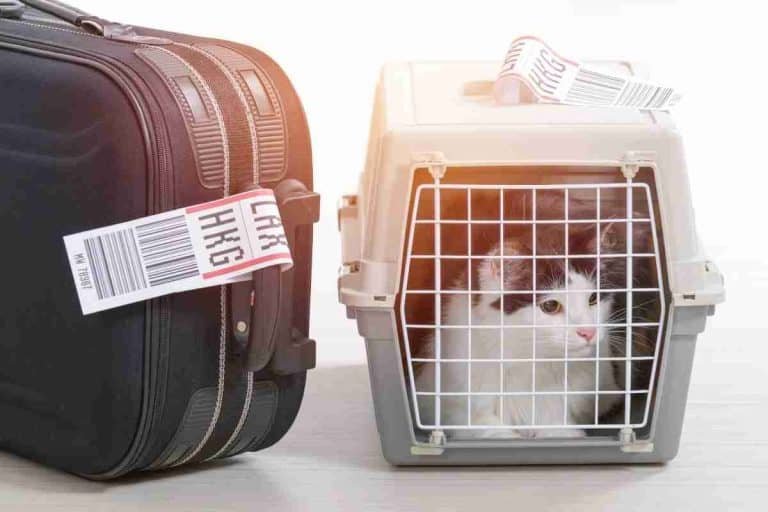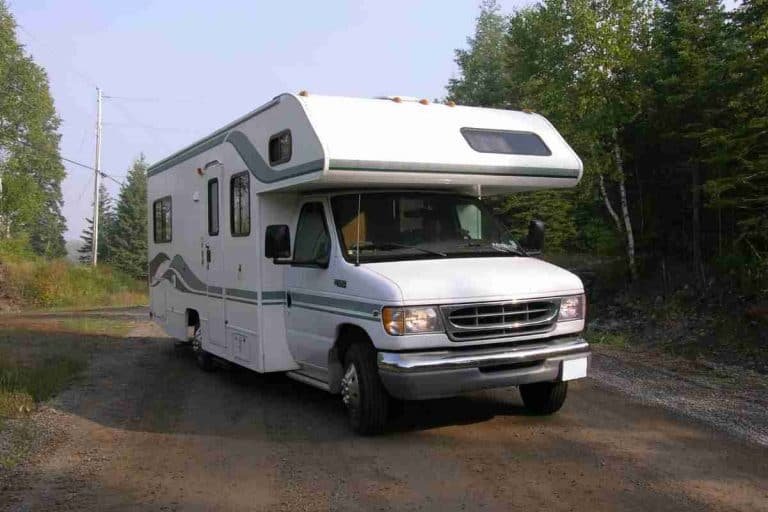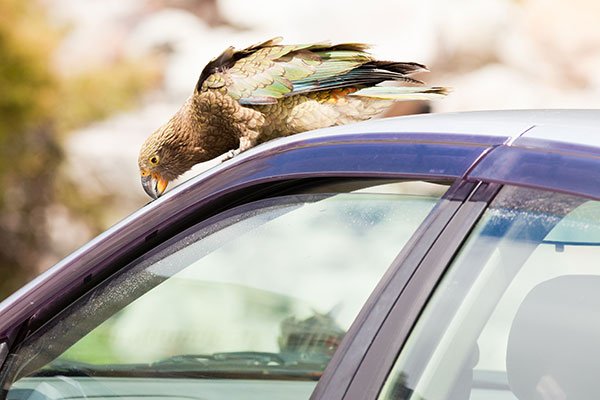10 Ways to Calm a Nervous Cat in the Car
Last Updated on August 25, 2025
Car rides often trigger yowling, drooling, panting, and escape attempts. With the right routine, a nervous cat in the car can settle. This guide shares 10 Ways to Calm a Nervous Cat in the Car, from scent cues and carrier training to smart seat placement and white noise. Expect quick wins for today’s trip and conditioning that makes future travel easier.
Owners will find practical, step-by-step tactics: familiar bedding, pre-trip play, gradual practice drives, calming pheromones, and snug carrier or wrap options. It also covers feeding timelines, reducing stimuli, crash-tested restraint choices, motion sickness signs, and vet-recommended meds. Clear setup tips, on-the-road troubleshooting, a packing checklist, and safe alternatives round out a calm, safer ride for any cat with car anxiety.
10 Practical Ways to Calm a Cat in the Car
1. Use a familiar blanket or toy to bring home scents into the carrier
Place a blanket or toy that smells like home inside the carrier before travel. The familiar scent reduces stress signals and reassures the cat. Wash these items less often before a trip so the scent stays strong. Place the blanket low in the carrier so the cat can burrow and feel sheltered. For longer trips, bring an extra item to swap if one gets soiled. See practical packing tips for longer vehicle trips at traveling with cats in an RV.
2. Tire your cat with play before you leave so they’re more likely to rest
Schedule an active play session 20–30 minutes before departure. Use chasing toys or wand toys to encourage sprinting and jumping. A tired cat will settle and nap more readily during the drive. Avoid heavy meals right before play; a small snack after exercise helps promote calm. Consistent pre-trip play creates a routine the cat learns to associate with travel. For tips on managing fussy felines during trips, consult how to travel with a fussy feline.
3. Gradual acclimation: short practice drives and carrier exposure
Start with carrier-only sessions at home, then progress to short drives. Keep early rides under five minutes and reward with treats after. Gradually increase drive time over days or weeks until the cat stays relaxed for longer trips. Repeat exposure to the carrier on non-travel days so it stays a safe space. Secure the carrier during practice drives the same way it will be secured on real trips. Read detailed carrier-securement techniques at how to secure a cat carrier in car.
4. Apply calming pheromones or plug-in sprays to the carrier ahead of time
Use synthetic feline pheromone sprays or wipes inside the carrier 10–15 minutes before placing the cat inside. These products mimic natural comforting signals and lower anxiety for many cats. Test any product at home first to ensure no adverse reactions. Avoid over-saturating bedding; a light application works best. If pheromones don’t help, try other non-pharmaceutical options detailed in general travel-anxiety resources like natural travel-anxiety remedies.
5. Choose a snug carrier or wrap (Thundershirt-style) to provide secure pressure
A carrier that limits excess space reduces sliding and gives the cat a den-like feel. For calm-inducing pressure, consider a Thundershirt or snug wrap placed over the carrier perimeter. Ensure airflow and visibility for necessary monitoring. Avoid carriers that shift or tilt; padding and non-slip underlay improve stability. If the cat resists a wrap, introduce it gradually during calm home sessions. Ideas for carrier-friendly vehicle setups appear in RV modifications for cats.
6. Keep feeding and water timing appropriate to reduce nausea
Avoid feeding a large meal within three hours of departure. Offer a small snack if needed, then withhold heavy food until the cat settles. Provide water up to an hour before travel and limit access during short trips to prevent spills. For longer drives, plan quiet breaks where the cat can sip water while still secured. Watch for signs of motion sickness—drooling, lip licking, or lethargy—and consult a vet if they appear. More on car-related panting and nausea is at why do cats pant in the car.
7. Reduce visual and auditory stimuli: cover windows, lower music, steady voice
Lower outside visual input by partially covering carrier sides with a breathable cloth. Keep cabin noise low and avoid sudden loud sounds. Speak in a calm, steady tone if the cat vocalizes. Avoid fast-driving maneuvers that increase motion; smooth braking and steady speed reduce stress. Use headphones rather than loud stereo if music helps the human driver, and choose mellow tracks at low volume. For broader escape-avoidance and environment control tips, see how to keep cats from escaping RV.
8. Position and secure the carrier where the cat feels safest (buckled seat or cargo)
Place the carrier on the rear seat or flat cargo area where motion feels steadier. Buckle the carrier with a seat belt or secure it with straps to prevent sliding. A carrier anchored at floor level often causes less sway than on a seat. Observe the cat’s body language during short trips and adjust placement accordingly. For general crate and carrier securing methods, consult this guide on securing crates in vehicles: 5 ways to secure a dog crate in car.
9. Use vet-recommended supplements or prescription meds for extreme anxiety
If behavioral strategies fail, consult a veterinarian. The vet may recommend calming supplements, anti-anxiety medications, or short-term sedatives for severe travel anxiety. Discuss side effects, dosing, and trial runs before a long trip. Never give human medications or unverified remedies. Natural supplements sometimes help, but combine them with acclimation and environmental changes. For discussion of professional and natural remedies for travel nerves, see flying with two cats on a plane.
10. Have a calm handler in the backseat and avoid opening the carrier while moving
Assign a quiet, steady person to sit near the carrier during travel. Their calm presence soothes the cat through soft speech and minimal movement. Never open the carrier while the vehicle moves. If checks are necessary, pull over safely and secure the car first. A handler should avoid sudden reaches into the carrier and use rewards after stops. For guidance on managing cat needs on multi-leg trips and stops, review tips on handling cat logistics during travel at how do cats go to the bathroom on plane.
Preparing your cat before the trip
Preparing a cat before a car trip reduces stress and increases safety. Focus on a predictable routine for at least two weeks before travel. Gradually introduce the carrier, short rides, and the specific items that will go on the trip: bedding, calming sprays, and familiar toys. Schedule vet and vaccination checks early to avoid last-minute surprises. Keep feeding and litter schedules consistent the day before departure to minimize gastrointestinal upset. Assemble a travel kit with proof of ownership, medical records, a recent photo, and extra leashes or harnesses. During preparation, note each calming or upsetting trigger and record reactions during practice rides. That information guides decisions about medication, carrier types, and when to stop for breaks. If the cat shows extreme distress despite progressive desensitization, consult a veterinarian about behavior support. Small, repeatable steps build confidence and let a caregiver adapt plans before the actual journey. This groundwork ties directly into the next sections, which cover medical clearance, carrier training, and field-testing with trial drives.
Veterinary check, vaccinations and a motion-sickness discussion
A pre-trip veterinary visit confirms fitness to travel and clarifies vaccine needs. The vet will review the cat’s health, update core vaccinations, and recommend tests for contagious disease when appropriate. Discuss motion sickness and request practical options: antiemetics, short-acting sedatives, or prescription pheromone therapies. Describe the cat’s reactions to noise, motion, and handling. Ask about side effects and timing so medications align with travel. Request written medical records and any required certificates for crossing state lines or boarding facilities. If travel involves long distances or multiple stops, obtain a plan for emergency care along the route. For owners looking for broader travel behavior strategies, see how to travel with a fussy feline. Bring the vet’s contact information and a clear list of medications in the travel kit.
Carrier habituation steps: leave carrier out, treat-based training, and short pickups
Carrier habituation reduces fear at the moment of departure. Start by leaving the carrier accessible with soft bedding and a worn garment. Use high-value treats and brief play sessions to create positive associations. Feed meals near and then inside the carrier. Progress to closing the door for short intervals while the cat remains calm. Practice “pickups”: gently pick the carrier up and set it down, increasing duration slowly. Keep sessions brief and end on a positive note. Transition to short stationary sessions in the car with the engine off, then with the engine on, before attempting a short drive. Secure the carrier using a seatbelt or a crate anchor to reduce sudden movement. For tips on securing carriers during a drive, consult how to secure a cat carrier in car. Avoid forcing the cat; coercion increases resistance and prolongs training time.
Trial drives: how to test what calms or upsets your cat and adapt accordingly
Trial drives reveal how a cat tolerates motion and sound. Start with very short drives—just around the block—then increase time in 5–10 minute increments. Observe body language: panting, wide eyes, vocalization, drooling, and attempts to hide signal stress. Try different seat positions and carrier orientations to find the least agitating setup. Test white-noise, soft music, or silence to see which reduces vocalization. Offer treats during calm moments to reinforce relaxed behavior. If motion sickness appears, shorten sessions and consult the vet for medication adjustments. Record successful combinations of carrier placement, sound, and timing for use on longer trips. For insight into car-specific stress signs, review resources on why cats pant in cars at why do cats pant in the car. Use trial-drive notes to finalize the travel plan and packing list.
Update microchip and ID tags and carry proof of ownership and medical records
Updated identification prevents permanent loss if a cat escapes during travel. Verify the microchip is registered to current contact information and test the chip number with a scanner if possible. Replace worn ID tags and attach them to the harness or carrier when leaving the vehicle. Carry printed proof of ownership, recent medical records, vaccination certificates, and the microchip registration printout. Keep digital copies on a secure cloud drive and an offline copy on a phone. If crossing state lines or flying later, confirm documentation requirements with relevant carriers or authorities. For travel that might involve airlines, consult destination and carrier rules at airlines that allow cats in cabin. As a practical CTA, update microchip contact details now and place copies of medical records in the travel kit before departure.
Choosing and securing the right travel restraint
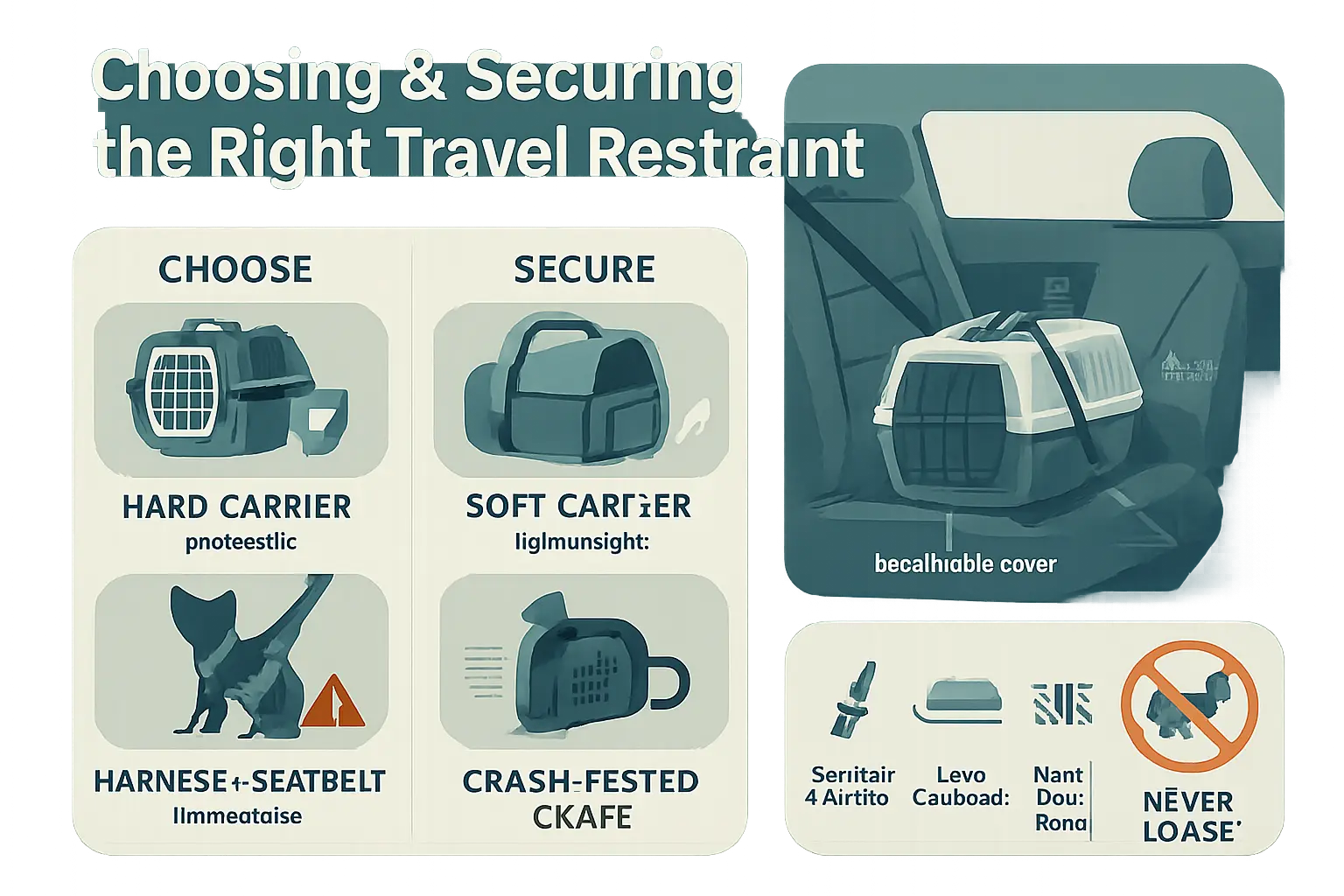
Selecting the correct restraint reduces stress and improves safety during car travel. Size, ventilation, stability and the cat’s temperament determine the best option. A properly chosen restraint also simplifies exit procedures and minimizes escape risk. Owners should confirm fit, test restraint stability in the vehicle, and practice short drives before longer trips.
Carrier types: hard vs soft and when to choose each
Hard carriers offer rigid walls, predictable protection and easier anchoring to a seat or cargo area. They suit cats that hide, scratch, or vomit, and they handle rough roads better. Soft carriers feel cozier and weigh less. Choose soft options only for calm cats that don’t try to claw through fabric. Size matters: the cat must stand, turn and lie down comfortably. Use familiar bedding and a small towel to absorb motion and provide scent comfort.
Harness + seatbelt systems: pros, fit tips and safety caveats
Harness-plus-seatbelt systems allow cats more visibility while still restrained. They work best for well-trained, comfortable cats on short trips. Fit the harness snugly: two fingers should fit under the straps. Attach the seatbelt to a harness-rated ring, not a collar. Owners should avoid using a flimsy harness or a leash-only setup during travel. Note that few cat harnesses are crash-tested; owners must weigh convenience against safety for longer or high-speed trips.
Crash-tested crates and when a small crate is preferable
Crash-tested crates provide the highest protection in collisions. For very nervous cats, a small, well-ventilated rigid crate often becomes a secure “den” that reduces panic. Anchor crates with vehicle straps or the seatbelt to prevent shifting. Read certification labels and choose crates that fit the cat with minimal empty space to limit movement in a crash. For instructions on anchoring carriers properly, see how to secure a cat carrier in car.
Why traveling loose is unsafe and best practices for exiting the vehicle
Traveling loose endangers the cat and distracts the driver. A loose cat can become a projectile in a crash, hide under pedals or bolt out when a door opens. Always keep the cat in its carrier or harness while the vehicle moves. When stopping, park, turn off the engine and keep doors closed. Move the carrier to the ground before opening its door. If the cat wears a harness for exits, clip a short leash and keep a hand on the cat until it relaxes. These small precautions prevent escapes and injuries.
Recognizing and handling motion sickness or medical issues
When following 10 Ways to Calm a Nervous Cat in the Car, owners must first separate motion sickness from true medical problems. Motion sickness usually appears during travel and improves after the ride stops. Medical issues may begin before travel or persist afterward. A quick, calm assessment helps decide the next step.
Start by securing the cat in a carrier or seat harness and pulling over safely. Offer fresh air and shade, and keep the vehicle still for several minutes. Avoid giving food during active nausea. If the cat recovers within minutes, motion sickness is likely. If symptoms persist, worsen, or include bleeding, severe lethargy, or collapse, seek veterinary care immediately.
Owners who travel often should prepare a basic kit: absorbent pads, a spare towel, a small water bottle, and a carrier that stabilizes the animal. For broader tips on managing a hard-to-handle traveler, see how to travel with a fussy feline. If uncertain, call the veterinarian for guidance before continuing the trip.
Common signs: drooling, vomiting, excessive panting or lethargy
Recognizing specific signs helps identify motion sickness versus other issues. Common motion-sickness signs include mild drooling, retching, and a single episode of vomiting. Cats may also pant or pace inside a carrier from anxiety. Lethargy that follows a short episode of nausea often resolves after rest.
Red flags that suggest a medical emergency include continuous vomiting, blood in vomit, uncoordinated movements, seizures, or severe weakness. Excessive panting can indicate heat stress, pain, or severe anxiety rather than simple motion sickness. For more on why cats pant in vehicles and what it can mean, consult why cats pant in the car.
Document signs with brief notes or a video. This record helps the veterinarian determine whether the problem stems from motion, illness, or stress.
Feeding schedule and hydration strategies to minimize upset stomach
Adjusting feeding and hydration reduces the chance of motion-induced vomiting. Withhold food for four to six hours before departure for adult cats. Small amounts of water remain acceptable up to travel time, but avoid large meals. A hungry cat is calmer than a nauseous one.
Offer a light meal two to three hours after arrival once the cat appears stable. For long trips, plan short stops to offer small amounts of water. Use a shallow dish to prevent splashing. For cats that refuse water, offer ice chips or a syringe of water into the mouth, if the cat tolerates it.
Owners who travel regularly can create a predictable pre-trip routine. Stable routines reduce anxiety and stomach upset. For more ideas about keeping cats comfortable on extended journeys, see traveling with cats in an RV.
Over‑the‑counter remedies, supplements and when to consider prescription meds
Several non-prescription options may ease mild travel nausea and stress. Pheromone sprays or wipes (such as Feliway) applied to the carrier calm many cats. Natural supplements like L‑theanine and tryptophan formulations can reduce anxiety for some animals. Use proven products from reputable brands and allow time to assess effect at home first.
Over‑the‑counter antihistamines or meclizine sometimes help motion sickness, but dosing and safety vary by cat. Owners should never medicate a cat without veterinary approval. A veterinarian can prescribe effective anti-nausea drugs such as maropitant (Cerenia) or ondansetron. Sedatives or gabapentin may help anxious cats on longer trips. Discuss medical history and potential side effects before using any prescription.
For additional natural-travel-anxiety strategies that may inspire questions for the vet, consult 9 natural ways to remedy your dog’s travel anxiety.
When to stop the trip and seek veterinary attention
Knowing when to halt travel can prevent serious outcomes. Stop immediately and seek veterinary care if the cat shows continuous vomiting, blood in vomit, difficulty breathing, collapse, or repeated seizures. Also stop for sudden and severe lethargy or any signs of shock.
While stopped, remove the cat from direct heat, keep it secure, and place it on a towel or pad to monitor symptoms. Call the clinic or a 24/7 emergency hospital for advice and directions. Have the cat’s medical records and an account of observed signs ready.
Securing the carrier or harness during a quick exit helps protect both the cat and people. For guidance on safe carrier handling and vehicle setup during emergencies, see how to secure a cat carrier in car.
Setting up the car environment for calm travel
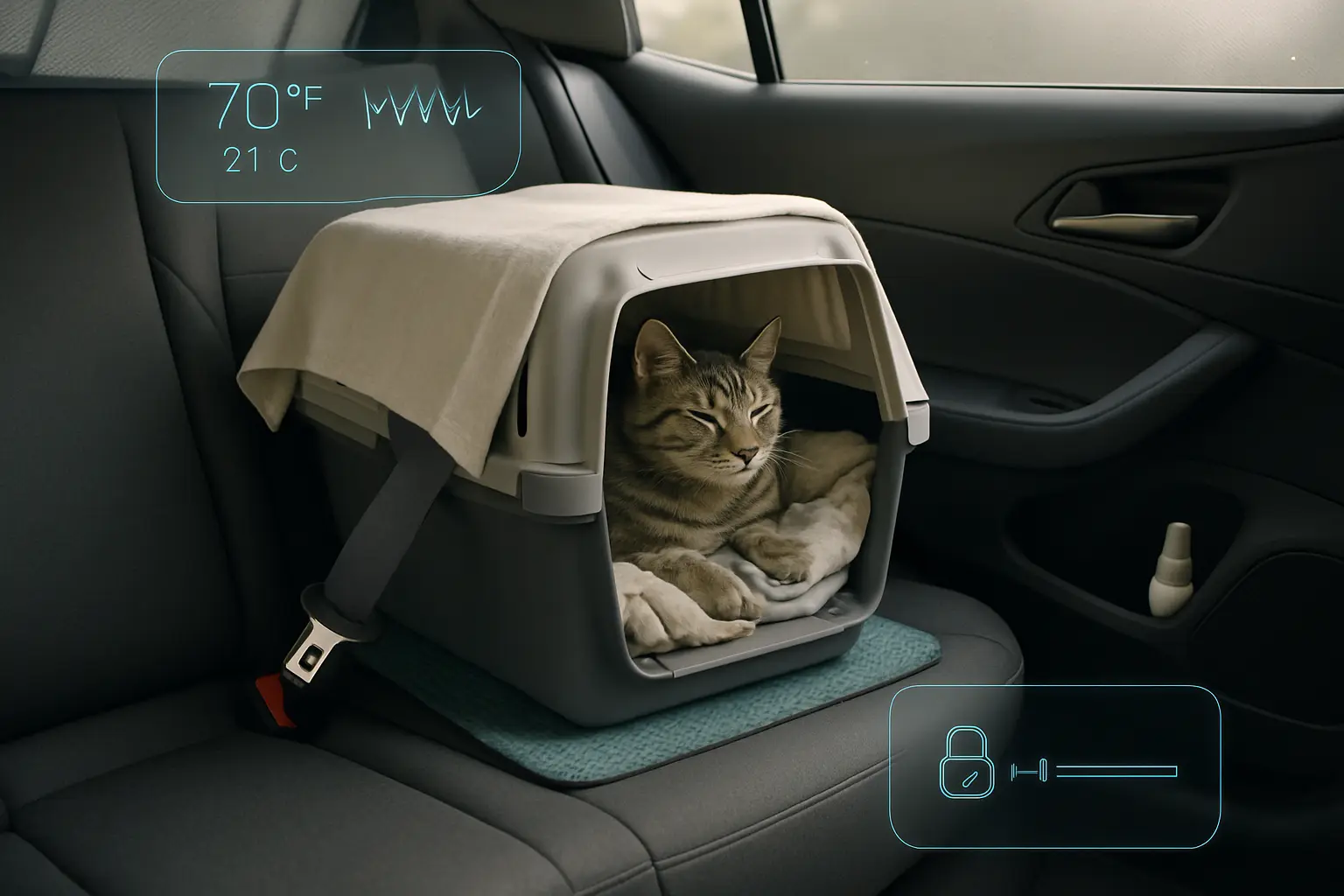
The goal of setup is to reduce sensory overload and physical discomfort before departure. Start by creating a stable, familiar space for the carrier and cat. Place a soft, absorbent bedding inside the carrier and add a worn piece of clothing that smells like home. Use a carrier that allows good airflow and that the cat can turn in comfortably. Apply a cat pheromone spray to the bedding about 15 minutes before placing the carrier in the car.
Plan the cabin layout so the carrier sits low and secure. Avoid the front passenger seat because airbags and sudden braking increase risk and stress. Test an arrangement during short drives to confirm comfort and carrier stability.
For more ideas on preparing a pet for travel, see how to travel with a fussy feline. Try one environment change per trip to measure effects and adjust before longer drives.
Temperature control, ventilation and sun/shade management
Cats tolerate a narrow comfort range. Keep the cabin between roughly 65–75°F (18–24°C) when possible. Use the car’s climate controls to maintain steady temperatures rather than rapid changes.
Prevent direct sun on the carrier with a sunshade, window tint, or a breathable cover. Sun can create hot spots inside the carrier even when the rest of the car feels cool. Position the carrier away from direct air vents that blow cold or hot air onto the cat.
Offer water before the trip and at longer stops. If the cat pants or drools excessively, pull over, move to shade and offer water; excessive panting can indicate overheating—see guidance on why cats pant in the car for warning signs and steps to take.
For long trips, plan regular, calm breaks in shaded areas to check temperature and hydration without forcing the cat out of its carrier.
Sound and sight management: music level, white noise, and covering the carrier
Minimizing sudden sounds and visual stimuli reduces fear responses. Keep radio volume low and choose steady, unobtrusive music or soft classical tracks. Avoid talk radio or news with abrupt changes in volume or tone.
White noise or a low-level fan can mask traffic sounds and engine changes. Place the white noise source at a level that doesn’t vibrate the carrier. Many cats respond positively to a light, consistent background sound.
Use a breathable carrier cover to block passing scenery and flashing lights, which often trigger anxiety. Leave the carrier partially uncovered if the cat prefers to peek out. Apply a feline pheromone wipe or spray to the carrier fabric about 15 minutes prior to travel.
For more strategies on reducing vocal stress and loud reactions in travel environments, consult 8 tips to stop a loud cat on a plane.
Seat placement tips for reduced motion and visibility
Carrier placement affects perceived motion and visual stimuli. Place the carrier on the floor behind the front passenger seat or the middle of the back seat. These positions reduce forward-backward motion and limit direct line-of-sight to the outside.
Secure the carrier with a seat belt or a non-slip mat to prevent sliding. A snug fit reduces jostling during turns and braking. Avoid propping the carrier on other objects that make it unstable.
Some cats tolerate a slightly elevated position if it feels safer, but elevation increases motion perception. Trial short drives with different placements to see which the cat prefers. When possible, position the carrier so the cat faces the car’s centerline rather than a side window.
Follow practical instructions on properly fastening carriers from how to secure a cat carrier in car to ensure safe and calm placement.
Handling interactions: speaking, touching through carrier, and not startling movements
Human interaction during travel should reassure the cat without increasing arousal. Use a low, steady voice to call the cat’s name or offer brief, calm praise. Avoid high-pitched coaxing or loud laughter that can spike stress.
Petting through the carrier’s mesh can soothe some cats. Keep touches slow, brief, and predictable. Stop if the cat tenses, hisses, or swats. Never open the carrier while the car moves. If a break allows safe removal, leash and harness the cat before opening the carrier.
Plan movements deliberately when entering or exiting the car. Sudden door slams, abrupt reaching, or quick lifting startles cats and undoes earlier calming work. Offer small, familiar treats during stops to reinforce calm behavior.
For guidance on managing cats during extended vehicle trips and when stopping, see traveling with cats in an RV. Consider consulting a veterinarian for severe anxiety and ask about short-acting calming options.
On-the-road tactics and troubleshooting during the drive
Keep the cat secure and the cabin predictable. Place the carrier on a flat surface and anchor it with a seatbelt or cargo straps. Use a well-ventilated, crash-tested carrier sized for the cat to stand and turn. Reduce motion by positioning the carrier low and toward the car’s center. Maintain a steady, moderate temperature and avoid sudden window drafts.
Drive smoothly: slow, gradual braking and gentle acceleration cut motion stress. Play soft, consistent audio or white noise to mask road sounds. Limit sudden visual stimulation by facing the carrier away from busy scenery or partially covering it with a breathable cover.
Bring a compact emergency kit with bottled water, a small towel, disposable gloves, sealable bags for waste, and vet contact info. Monitor the cat visually or with a mirror; avoid opening the carrier when the car still moves. For detailed carrier anchoring techniques see how to secure a cat carrier in car. Consider scheduling veterinary advice for severe motion anxiety as a proactive step.
How to handle vocalizing, scratching or escape attempts safely
Respond to vocalizing without amplifying the stress. Keep voice calm and low; abrupt loud noises increase panic. If the cat scratches at the carrier, resist opening doors near traffic. Pull over to a safe, quiet spot before any direct intervention.
When the cat attempts escape, prioritize containment. Use a carrier door or a leash-and-harness system to prevent sudden bolting. Avoid hand retrieval in unfamiliar surroundings; wear thick gloves if hands must enter the carrier. If the cat claws at fabric, slide a clear barrier like a rigid board between the cat and the opening to guide it back.
If escape happens outside, move slowly and crouch low; allow the cat to come to shelter rather than chasing. For strategies to reduce escape risk during vehicle travel, review how to keep cats from escaping RV. Call a vet if injuries or extreme agitation follow an escape attempt.
Timing and conducting rest stops: water, litter breaks and brief outdoor considerations
Plan rest stops every two to three hours for water and short breaks. Offer small amounts of water to avoid motion-induced nausea. Keep feeding light before travel to reduce car sickness risk. Bring a portable litter option—disposable trays or granule pads fit most carriers.
At stops, keep the cat in a harness clipped to the carrier or a secure anchor. Open doors only on the side away from traffic and stay within arm’s reach. Choose quiet, shaded areas for breaks to lower sensory overload. If the cat needs to eliminate, put the carrier floor liner into a compact litter tray to minimize mess.
Sanitize paws and paws pads with pet-safe wipes after outdoor stops. For additional ideas on managing feline bathroom needs during travel, see how do cats go to the bathroom on plane. Keep stops brief to maintain routine and reduce reactivation of travel stress.
Quick comfort measures if anxiety spikes (soothing scent, quiet time, towel wrap)
Use immediate, simple interventions when anxiety escalates. Apply a synthetic pheromone spray inside the carrier 10–15 minutes before expected travel to help lower arousal. Offer a high-value, quick-smelling treat to create a positive association, but avoid large feeds.
Provide a quiet, darkened space inside the carrier by draping a breathable towel over three sides. A gentle swaddle—wrapping the cat loosely in a soft towel—can reduce hyperactivity. Keep the cat cradled in the carrier for several minutes after wrapping to let breathing and heart rate slow.
Offer short, calm petting or a slow stroke along the neck and shoulders if the cat accepts touch. Use low-volume white noise or calming music to mask sudden environmental sounds. For additional travel-calming tips for reactive felines, consult how to travel with a fussy feline. If these measures fail, contact a veterinarian about prescription options before future trips.
Packing checklist and emergency preparedness
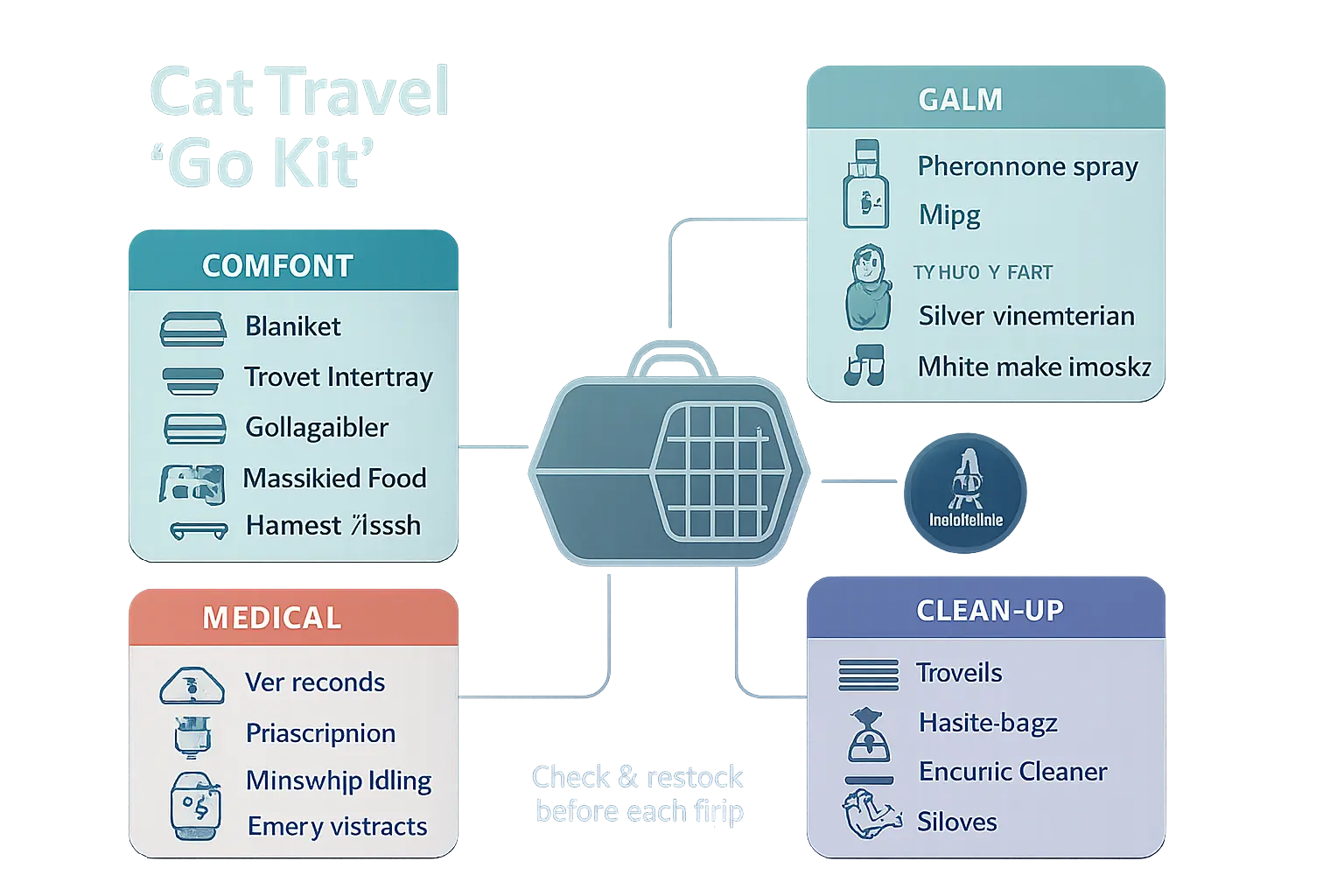
Assembling a compact, well-organized travel kit reduces stress for a nervous cat and its human. Prepare items for comfort, containment, cleanup, and medical needs. Pack early and store gear where it stays ready for short-notice trips.
Divide the kit into labeled pouches: “Comfort,” “Calm,” “Medical,” and “Clean-up.” Keep copies of digital documents on a phone and a printed set in a waterproof sleeve. Store a collapseable water bowl and a small zip bag with favorite treats near the carrier for quick comfort rewards.
For guidance on securing carriers and safe placement in the vehicle, consult this essential travel gear and tips resource to adapt packing ideas to feline needs.
Must-haves: litter supplies, water, familiar bedding, food, leash/harness and carrier repair kit
Start with essentials that maintain routine and hygiene. Pack a travel litter tray, a small bag of the cat’s regular litter, and several disposable litter liners. Include bottled water and a compact, foldable bowl. Bring measured portions of familiar food in resealable bags to avoid stomach upset.
Add the cat’s favorite bedding or a towel that carries home scent. A well-fitted harness and short leash provide safe supervised exits at stops. Include spare ID tags and a temporary pet-safe marker pen to write phone numbers on the carrier.
Prepare a simple carrier repair kit: zip ties, heavy-duty tape, safety scissors, a small screwdriver, and a few fasteners. Test carrier latches and seams before travel. If the carrier shows wear, reinforce weak points to prevent escapes. For techniques on securing carriers in a vehicle, see how to secure a cat carrier in car.
Calming aids: pheromone spray, wipes, wrap, catnip alternatives and vet-recommended meds
Pack noninvasive calming tools first. A feline pheromone spray applied to bedding and the carrier 15 minutes before travel eases anxiety. Keep pheromone wipes for quick refreshes during long trips. A snug wrap or soft towel can comfort cats that respond well to gentle pressure.
Offer catnip sparingly; some cats become overstimulated. Bring alternatives such as silver vine or valerian if the cat responds better to those. Store calming aids in labeled bags and replace single-use items after each trip.
For chronic severe anxiety, ask a veterinarian about short-term prescription options. Include a prescription copy and dosage instructions in the medical pouch. Never give human medications. For broader feline travel behavior strategies, consult how to travel with a fussy feline.
Documentation and contacts: vet info, vaccination records, and local emergency clinics
Keep up-to-date records easily accessible. Include current vaccination certificates, a recent medical summary, and proof of ownership. Scan documents to the cloud and send a copy to a trusted contact who can act if needed.
Compile a short contact list: primary veterinarian, emergency vet clinics along the route, and a nearby 24-hour animal hospital at the destination. Store phone numbers, addresses, and estimated travel times in the phone and on paper.
Note special medical needs, allergies, and microchip number on a dedicated page. Attach a laminated card to the carrier with critical information so responders see it immediately. For travel-specific documentation rules, check airline or regional guidelines such as those summarized in airlines that allow cats in cabin.
Clean-up and safety kit: towels, waste bags, enzyme cleaner and first-aid basics
Prepare for accidents and minor injuries with a compact clean-up and first-aid kit. Pack several absorbent towels, disposable waste bags, and a small container of enzyme cleaner to remove urine and odor quickly. Store cleaner in a leakproof bag.
Include basic first-aid supplies: gauze pads, adhesive bandage tape, antiseptic wipes safe for pets, and styptic powder for nail bleeding. Add a digital thermometer and saline solution for wound flushing. Keep a list of symptoms that require immediate veterinary attention.
Place all items in a waterproof pouch inside the car. Replenish used supplies after every trip. For tips on managing in-vehicle messes and longer stays, review practical travel cleanup guidance at traveling with cats in an RV. Keep a small CTA note: “Check and restock this kit before each trip.”
Alternatives when travel isn’t the best option
The owner must evaluate whether the trip is truly necessary when a cat panics in the car. Long-distance moves, vet emergencies and relocation may require travel. Routine errands or nonurgent events rarely justify stressing a cat. Choosing an alternative can protect the cat’s wellbeing and avoid escalation.
How to decide: weigh stress risk vs necessity of travel
List the purpose, duration and expected stressors for the trip. Consider the cat’s history with motion, vocalizing and hiding. If stress signs include panting, drooling, repeated attempts to escape or aggression, the risk is high. Balance that risk against the reason to travel. When in doubt, prioritize the cat’s mental and physical safety. For medical needs, consult the veterinarian about sedatives or safe transport options.
Preparing a trusted pet sitter vs boarding facility: pros, cons and what to ask
A trusted pet sitter offers familiar surroundings, one-on-one attention and lower exposure to other animals. Boarding facilities provide constant supervision and medical handling. Ask sitters about daily routines, experience with anxious cats and emergency protocols. For kennels, request a tour, vaccination rules and staff training. Verify references and insurance. For more tips on managing travel-sensitive cats and planning alternatives, read how to travel with a fussy feline.
Tips to make staying home less stressful if you cannot take a sitter
Reduce noise and maintain the cat’s routine. Leave multiple hiding spaces and place familiar bedding where the cat rests. Use interactive toys and timed feeders to keep activity steady. Introduce calming pheromone diffusers several days before the owner leaves. Leave a clothing item that carries the owner’s scent. Arrange a short trial absence to test the setup. If stress persists, schedule a professional behavior consult or a vet visit. Book a trial sitter visit to confirm compatibility before longer trips.
Summary
“10 Ways to Calm a Nervous Cat in the Car” equips caregivers with practical, step-by-step methods to make car travel safer and calmer for cats. The guidance emphasizes advance preparation—gradual carrier training, short practice drives, and a predictable pre-trip routine—paired with smart choices in restraints, placement, and sensory control.
During travel, the post outlines how to secure and position the carrier, manage sound, sight, temperature, and feeding timing, and recognize motion sickness versus medical issues. It also covers quick comfort measures, a well-organized travel kit, and when to seek veterinary help or choose alternatives to travel. The result is a clear plan that reduces stress, improves safety, and helps cats settle more reliably on the road.
Key Takeaways
- Acclimate early: Leave the carrier out at home, use treats and short practice drives, and build up duration gradually.
- Secure the setup: Choose a snug, well-ventilated carrier and anchor it low and stable; avoid front seats and airbags.
- Control stimuli: Keep sound low, use white noise, cover the carrier partially, and maintain steady 65–75°F (18–24°C).
- Time food and water: Withhold large meals 3–6 hours before departure; offer small water amounts at calm stops.
- Plan for issues: Learn motion-sickness signs, carry a compact emergency kit, and consult a veterinarian for supplements or meds if needed.
- Prioritize safety: Keep the cat restrained at all times, use a calm handler when possible, and pull over before any checks or adjustments.
FAQ
-
What calms a cat quickly in the car?
Reduce input fast: partially cover the carrier, lower noise, and use a pheromone spray or wipe. Stop in a quiet spot, keep movements slow, and offer a brief high-value treat if the cat is receptive.
-
How should a cat carrier be secured in a vehicle?
Anchor the carrier with a seat belt or cargo straps on a flat surface, ideally low behind the front seat or centered on the back seat. Keep it level, prevent sliding, and avoid the front seat due to airbags.
-
Why does a cat pant or drool during rides?
Panting or drooling often signals motion sickness, heat, or high stress. Improve airflow, reduce visual stimuli, drive smoothly, and consult a veterinarian if signs persist or worsen.
-
How long does acclimation to car travel usually take?
Most cats need days to a few weeks of short, positive sessions. Keep early drives under five minutes, reward calm behavior, and increase duration gradually.
-
What should a travel kit for a nervous cat include?
Pack familiar bedding, pheromone spray/wipes, water and a collapsible bowl, a small litter solution, measured food, a fitted harness/leash, cleanup supplies, first-aid basics, and medical/vet documents.

